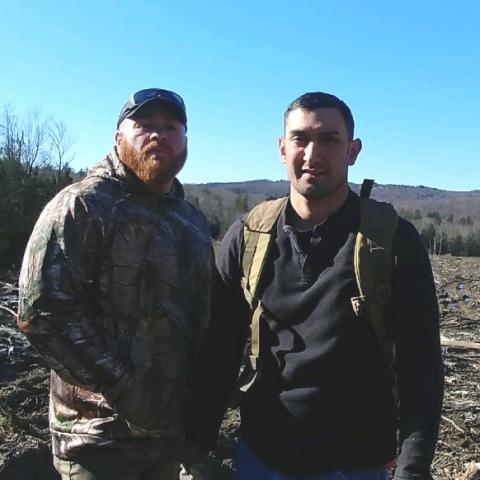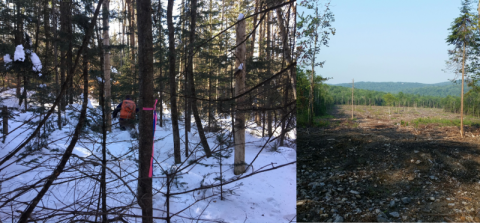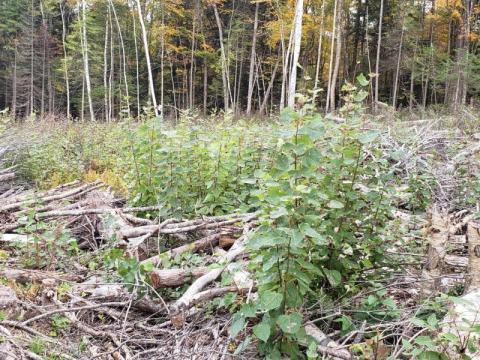Flipping a Forest: From Low-quality Timber to High Quality Habitat

Brothers and landowners Gordon Peckham and James Sowders.
In 2014, brothers Gordon Peckham and James Sowders III purchased a 70-acre woodlot in Lempster. They knew their main goal for their new property was wildlife habitat, but they weren’t sure how to get started or whether hands-on management was needed.
“We felt that we could benefit from a professional opinion,” Gordon recalls. “We found information about UNH Cooperative Extension and the forestry and wildlife assistance they provide to landowners. I reached out to Sullivan County Extension Forester Dode Gladders to discuss our vision of using the property to benefit wildlife, and Dode offered to visit the property along with their Wildlife Specialist Matt Tarr and provide a first-hand assessment and recommendations.”
The woodlot had an overstory of low-quality trees, mostly hardwoods like birch, maple, and aspen, along with some balsam fir and red spruce. Some areas had a dense thicket of small fir and spruce trees growing in the understory, great habitat for snowshoe hare.
Matt was impressed by the potential to manage for early-successional (young forest) habitat. “Young, dense aspen sprouts are especially valuable to a variety of wildlife. This sprouting is best stimulated by clearcutting. Since aspen requires a lot of sunlight, bigger is better when making openings,” he reported, adding “This property offers the best opportunity I have seen in many years to create a large area of aspen regeneration.”
Dode and Matt assembled a report including specific management suggestions as well as next steps to consider. “Dode told me about the possibility of receiving cost-share funding from the Natural Resources Conservation Service (NRCS) to have a management plan developed for our woodlot,” Gordon recalls. Through the Environmental Quality Incentives Program (EQIP), NRCS offers financial assistance to landowners to have forest management plans developed, as well as for certain management activities that might otherwise be cost-prohibitive.
After meeting with several consulting foresters, Gordon chose to work with Jeff Snitkin of Bay State Forestry Service. “Jeff’s professionalism, knowledge and consideration of our goals and objectives gave us confidence that our forest management plan would be done the way we wanted. Jeff also assured us that he would be available to work with us and the NRCS to get the management done on the ground.”
Jeff found that the woodlot had been harvested in the early 1990’s and all valuable trees had been cut at that time, leaving a legacy of poor quality, damaged, and suppressed trees. “The timber value was very low and wasn’t going to improve if those trees were left to grow. It was a great wildlife property, though, with a nice species mix for early-successional habitat. It worked out perfectly to clearcut and start over.”

(Left) Consulting forester Jeff Snitkin laid out the harvest in March 2018. Photo by Dode Gladders. (Right) A view of the completed harvest. Photo by Wendy Ward.
The final management plan, completed in 2016, recommended regenerating a large area on the west side of Lempster Street. Working with Wendy Ward from the local NRCS office, Jeff developed a project plan for a 20-acre clearcut which was reviewed and approved by the Wildlife Management Institute. The entire overstory was to be removed, except for a few high-quality red oak and yellow birch trees. “Since a lot of this stand was growing aspen, we were in a good spot to get aspen back by cutting during the dormant season,” Jeff said, adding that this species best regenerates through root sprouts.
The landowners secured cost-share assistance for this harvest through the Regional Conservation Partnership Program Young Forest Initiative, an NRCS program with the goal of creating high-value early-successional wildlife habitat.

Regenerating aspen after the harvest. Photo by Jeff Snitkin.
The harvest was completed in 2018, and aspen sprouts are already up and running. As the new stand develops into a dense thicket, it should provide high-quality habitat to a variety of wildlife species for at least the next ten to fifteen years.
“This site was a perfect fit for this program, providing a great opportunity for aspen regeneration,” Wendy says, adding “A lot of things really came together to make this happen. We have a landowner eager to help wildlife, a woodlot with great potential, Cooperative Extension helping to get folks connected, and ultimately NRCS, the managing forester, and loggers all working together to make this success story possible."
Dode Gladders, Sullivan County Forester, UNH Extension
Winter 2019 Taking Action for Wildlife Newsletter


